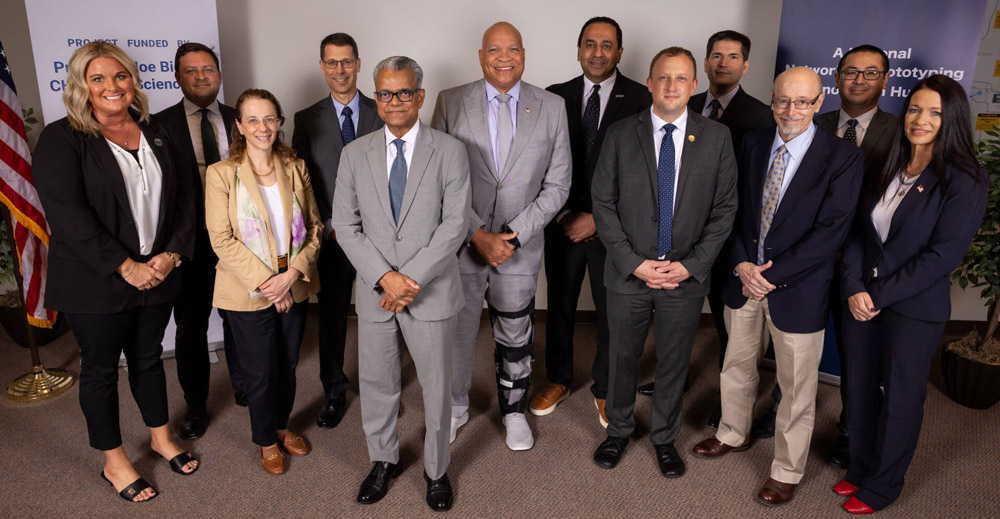News: Microelectronics
27 September 2024
USC-led CA DREAMS hub gets $31.9m DoD funding
The US Department of Defense (DoD) is directing $31.9m in funding to the California Defense Ready Electronics and Microdevices Superhub (CA DREAMS), led by the University of Southern California (USC) Viterbi’s Information Sciences Institute (ISI).
Comprising 16 founding partners in higher education and the semiconductor industry, CA DREAMS is one of eight regional innovation hubs established under the DoD Microelectronics (ME) Commons Program, which is funded by the CHIPS and Sciences Act of 2022 to develop onshore microelectronics hardware prototyping, lab-to-fab transition of semiconductor technologies and extended semiconductor workforce training. USC’s MOSIS 2.0 service, established as part of CA DREAMS, is accelerating prototyping in labs and fabs and streamlining the transition of processes from lab to fab.
The award aims to accelerate the development of advanced semiconductor technologies through two distinct projects, executed by aerospace defense technology company Northrop Grumman:
- $16.2m to mature gallium nitride (GaN) technology to enable broad-spectrum, high-power and high-efficiency solutions for future DoD electronic warfare (EW) systems.
- $15.7m to support the development of 5G/6G-relevant prototypes to accelerate the availability of high-performance mmW phased-array front ends.
$16.2m to develop advanced gallium nitride technologies
Northrop Grumman and the CA DREAMS team will develop GaN amplifier chipsets that operate from the microwave to the sub-millimeter-wave frequency spectrum, making advances at the semiconductor-device, the integrated circuit, and the package level. Pivotal to the project is demonstrating the benefit of the Microelectronics Commons ecosystem, where technology can be more rapidly accelerated by connecting traditional competitors as well as universities, and encouraging collaboration to reach a desired end-goal for the DoD.
The project team comprises USC, Northrop Grumman, Teledyne Technologies, HRL Laboratories, PseudolithIC, Monde Wireless Inc, Transphorm, UCLA and UC Santa Barbara.
Northrop Grumman is “a leader in developing advanced GaN technologies,” comments CA DREAMS director Steve Crago. “Their involvement in this hub and leadership on this project ensure that we can rapidly translate cutting-edge research from our university labs into deployable solutions for the Department of Defense.”
Traditional DoD prototyping cycles have taken years to demonstrate concept feasibility. In addition to meeting its technical goals, the project also expects to dramatically accelerate prototyping time and demonstrate capabilities in the X, V and W wave-bands in the first year, with subsequent years tackling submillimetre-wave bands. This would demonstrate an acceleration of the cycle from concept to delivery by 2-3x.

Picture: CA DREAMS representatives with US National Government officials (photo by Samantha Chow/ASU).
“This project is resolving a DoD-needed application and undertaking the challenges by working through various levels – from university to research and system architecture – all in a 12-month time span,” says project lead Alex Zamora, RF/mixed-signal department manager, Northrop Grumman.
$15.7m in funding for 5G/6G mmW phased-array prototypes
Northrop Grumman and the hub team also aim to accelerate high-frequency wireless communications solutions for defense and commercial applications.
The award will support the development of 5G/6G-relevant prototypes to accelerate the availability of high-performance front ends, including phased-array antennas, beam-forming integrated circuits (ICs), and broadband amplifiers integrated using state-of-the-art (SOTA) advanced (2.5D and 3D heterogeneous integration [HI]) packaging for leading-edge size, weight, power and cost (SWAP-C) systems.
Northrop Grumman will collaborate with USC and other industry and academic partners to dramatically accelerate the development of high-frequency communications solutions, leveraging advanced microelectronic technologies and critical lab-to-fab technology transitions, for dual-use applications.
“By leveraging the collective expertise of CA DREAMS and MOSIS 2.0, we’re poised to make significant advancements in high-frequency communications that will benefit both defense and commercial sectors,” says Steve Crago, CA DREAMS director at USC and associate director of the USC Viterbi Information Sciences Institute.
The project team consists of USC, Northrop Grumman, HRL Laboratories, Teledyne, Caltech, UCLA, UC Santa Barbara, UC San Diego, Vorago and GlobalFoundries. Its leaders are aiming to develop prototypes 12 or more months sooner than traditional timelines.
“The project team, enabled by ME Commons and CA DREAMS, has expertise spanning microelectronic fabrication process modules to commercial foundry production and university design to DoD systems,” says Monte Watanabe, RF/mixed-signal assistant department manager, Northrop Grumman. “This collaboration will connect new levels of the microelectronics ecosystem and apply them toward diverse 5G/6G needs across future DoD and commercial systems.”
The project will enable arrays of antennas to operate at higher frequencies for wideband communication applications, providing improved connectivity for DoD and commercial applications.
“The Northrop Grumman Microelectronics Center is poised to apply its unique capabilities in RF microelectronics and advanced packaging to develop mmW phased-array prototypes with our team partners,” says Watanabe. “We’ll all be moving the needle to realize fieldable component and prototype capability that captures and transitions the latest microelectronics technology,” he adds.









